#Roy Rutland
Text
Avengers #83 is Wild. Roy Thomas takes on Feminism at the Rutland Halloween Parade! The Lady Liberators (some clear feminist parody or something with Valkyrie, Medusa, Black Widow, Scarlet Witch and The Wasp) are heading for Vermont, just as The Avengers are all set to march in the parade! Also, The Masters of Evil are there! Plus, Roy Thomas works himself and his then wife into the story briefly. It's just... a really strange story.
#the avengers#avengers#It's such a strange story#marvel#marvel comics#reading comics#comic books#comics#avengers comics#roy thomas#comic book#old comics
1 note
·
View note
Text
Avengers #83: Come on in… the Revolution's Fine!
Read Date: November 12, 2023
Cover Date: December 1970
● Writer: Roy Thomas ● Penciler: John Buscema ● Inker: Tom Palmer ● Colorist: {uncredited} ● Letterer: Herb Cooper ● Editor: Stan Lee ●

**HERE BE SPOILERS: Skip ahead to the fan art/podcast to avoid spoilers (👏=didn't like it, 👏👏=it was ok, 👏👏👏=I liked it, 👏👏👏👏=I really liked it!, 👏👏👏👏👏=I loved it!)
Reactions As I Read:
● since I discuss this issue with some podcasting friends, I'll just let the episode speak for itself! give it a listen if you're interested ^_^

● 👏👏
Synopsis:
Returning to Avengers Mansion to visit, the Wasp soon finds herself witness to the gathering a new all-female group called the Liberators (consisting of Scarlet Witch, Black Widow, Medusa and newcomer Valkyrie) Who have banded together to battle male oppression. Valkyrie explains that she was a scientist at a male-dominated science lab, and when attempting to show up a chauvinist co-worker, she exposed herself to a chemical that gave her superhuman strength, and so she decided to form this hero group, and has convinced each of her recruits to join by feeding on an apparent double standard in being a super-hero. With all of them siding with her, Valkyrie takes them aboard her chariot and heads off to Rutland, Vermont.
In Rutland, are the male members of the Avengers, who are there attending the annual Halloween festivities where the townspeople all dress up as super-heroes. They are unaware that the Masters of Evil are also in attendance, seeking to capture a hostage in a plot to get revenge on the Avengers for their previous incarceration. While the initial plan fails, and a battle between the two groups starts, the Masters manage to get the upper hand, that is until the Liberators show up.
The newly formed group makes short work of the Masters, and when the Avengers thank the women for saving them, they are attacked and easily defeated as well. Suddenly, Valkyrie knocks out all her comrades and reveals that she is really the Enchantress in disguise. She explains that after her last failed attempt at taking over Asgard failed (in Incredible Hulk #102) she and the Executioner were banished to a barren netherworld. There, the Executioner abandoned her for the a mysterious woman who appeared to offer the Executioner her love. Feeling betrayed, the Enchantress vowed revenge on all men and used the Valkyrie disguise and the formation of the Liberators to met this end.
The Scarlet Witch frees herself and battles the Enchantress, defeating her by using a hex bolt that redirected the Enchantress' magic back at her. She then frees her fellow Avengers and reveals to them that she realized they were really facing the Enchantress when earlier in the day (as Valkyrie) she called the Wasp a "wench" in a tone that as the Enchantress she used on the Scarlet Witch in a past battle.
(https://marvel.fandom.com/wiki/Avengers_Vol_1_83)
Fan Art: Valkyrie by ZFischerillustrator
Accompanying Podcast:
● Married with Comics - episode
0 notes
Text
A man who died when his homemade bomb went off outside a hospital had a grievance against the British state because his asylum claim was rejected, a police investigation has found.
Emad Al Swealmeen's device exploded in a taxi outside Liverpool Women's Hospital on 14 November 2021.
The 32-year-old was killed, but driver David Perry escaped the blast.
Counter Terrorism Policing North West said his grievance "combined with mental ill health" led to the attack.
The force's report into the bombing said it was "most likely" that Al Swealmeen's grievance against the British state for failing to accept his asylum claim had "compounded his mental ill health, which, in turn, fed that grievance and ultimately a combination of those factors led him to undertake the attack".
Det Supt Andy Meeks said it was believed Al Swealmeen intended to go into the hospital and detonate his device, but it was likely that it had exploded earlier than planned.
He said there was no evidence anyone else was involved in the attack.
The explosion, which was captured on the hospital's CCTV, propelled ball bearings through the taxi, blowing out its front windscreen.
The glass hit a tree 52ft (16m) away and damage was caused to the hospital's windows.
Det Supt Meeks said Al Swealmeen, who was born in Iraq, had gone to considerable lengths to stay in the country, including converting to Christianity, although the authenticity of his conversion was in doubt.
A previously confidential 2015 asylum judgment, released to the BBC in 2022, also revealed his claim of being a Syrian refugee had lacked basic facts.
The force said Al Swealmeen came to the UK in 2014, having applied for a visa in Abu Dhabi claiming he wanted to travel for a holiday and to watch the filming of Britain's Got Talent in Belfast.
He falsely claimed to be a Syrian national when interviewed by Home Office officials and his asylum claim was rejected.
Det Supt Meeks said Al Swealmeen began a conversion to Christianity in 2015, when his asylum appeal rights were exhausted, and was baptised at Liverpool Cathedral in November that year.
He forwarded letters of support from members of the church community to the Home Office to support his asylum claim in 2017.
In January 2020, a further asylum claim was rejected on the basis he had not truly accepted the Christian faith and rejected others.
Det Supt Meeks said Al Swealmeen's deterioration in mental health coincided with developments in his asylum case.
He said he was detained by police under the Mental Health Act in 2015 and was later sectioned.
The investigation into the attack found Al Swealmeen rented a flat in Rutland Avenue, about 1.5 miles (2.4km) from the hospital, with the "sole purpose" of building the bomb.
Officers found mixing bowls and bags of chemicals inside the flat, along with a mobile phone containing instructions on how to make explosives.
A search of his other address, which he shared with other asylum claimants in Sutcliffe Street, uncovered two unfinished improvised firearms.
A subsequent search of his mobile phones found they had been largely erased and he had taken precautions to conceal his intentions.
As a result, the report said officers would "never truly know why Al Swealmeen took the actions that he did that led to the explosion".
Following the report's publication, Merseyside Police's Assistant Chief Constable Jon Roy said the public's reaction to the attack had been "unbelievable", adding: "In the face of adversity, they were strong and determined and unbowed."
"Ultimately, the aim of terrorists is to create conflict, distrust and fear, but that didn't happen here and people across Liverpool stood shoulder to shoulder," he added.
1 note
·
View note
Text

BIOGRAPHIE DE PIERRE DU MOULIN
Pierre Du Moulin, né le 16 octobre 1568 à Buhy et mort le 10 mars 1658 à Sedan, est un pasteur et théologien protestant français réputé pour son orthodoxie. Il est connu comme premier pasteur du temple de Charenton et tenant de l'Académie de Sedan l'espace d'une trentaine d'années (1621-1658).
Pierre est le fils de de Joachim Du Moulin, pasteur protestant, et le petit-fils de Charles Dumoulin, juriste de renom. Le 24 avril 1564, Joachim épousa en l'église d'Orléans, demoiselle Françoise Gabet, fille d'Innocent Gabet, juge pour le Roi, à Vienne en Dauphiné (qui sera tué par les catholiques peu après le massacre de la Saint-Barthélemy). De ce mariage sont issus quatre enfants : Esther, Joachim, Pierre et Éléazar.
Joachim du Moulin, avec ses deux enfants, Esther et Joachim, âgés de trois ans et de un an, et sa femme enceinte de Pierre, fuyait la persécution ; il avait été chassé de son église de Mouy. Après avoir erré de retraite en retraite, la famille arrive au château de Buhy, en Vexin. Monsieur de Buhi, protestant, frère de Philippe Duplessis-Mornay, lui offrit un asile. C'est dans ces circonstances que naquit Pierre du Moulin, le 16 octobre 1568.
En 1570, l'édit de Pacification permit à Joachim de réunir toute sa famille à Cœuvres, où était réfugiée l'église protestante de Soissons, chez Jean Ier d'Estrées ; église dont il était le pasteur. Après le massacre de la Saint-Barthélémy, Antoine d'Estrées, qui succédait à son père, change de religion et chasse ses anciens protégés.
Ils trouvèrent la protection du duc de Bouillon, alors Henri-Robert de La Marck, et arrivèrent à Sedan le 3 janvier 1573. La mère, Françoise, mourut peu après leur arrivée, le 13 février 1573. L'année suivante, Joachim du Moulin se remaria, avec Guillemette d'Avrigny « de la maison d'Anserville». De ce second mariage naquirent trois enfants : Marie, Jean et Daniel.
Quelque temps après il alla de nouveau servir l'église réformée de Soissons, installée alors Saint-Pierre-Aigle, laissant ses enfants à Sedan.
En 1584 Joachim du Moulin revint à Sedan pour s'y fixer. Pierre suivait les cours du collège, nouvellement fondé.
En 1588, fuyant les guerres de la Ligue, il s'échappa en Angleterre. Il y devint le précepteur du fils de la comtesse de Rutland, lequel étudiait à Cambridge. C'est ainsi qu'il suivit les cours du docteur Wittaker. Durant les vacances, il allait à Londres au contact de l'église réformée wallonne.
Il était installé depuis quatre ans en Angleterre lorsqu'il se résolut à rejoindre Leyde où son ami François du Jon professait la théologie. Il accepta un poste de conrecteur, sorte de maître-adjoint, au collège de Leyde. Peu après, il fut admis, sur concours, à l'âge de vingt-quatre ans, professeur à l'Académie de Leyde. Il resta dans cette charge cinq ans et trois mois.
En 1595, il publia sa première œuvre, qui eut de nombreuses rééditions : La Logique françoise.
À Leyde, il prend pension chez Joseph Juste Scaliger, où il rencontre des personnages distingués et de grand mérite et s'y fait de puissants amis. Durant son séjour à Leyde, il fréquente, Paul Trude Choart, duc de Buzenval, alors ambassadeur de France à La Haye.
En 1599, il revient à Paris, où on lui confie le soin d'accompagner, avec la fonction de chapelain, la princesse Catherine de Bourbon en Lorraine. Chaque année d'abord, puis, à partir de 1603, tous les deux ans, il faisait le même voyage, qui durait trois mois. C'est au cours de ce voyage, en 1599, qu'il rencontra à Vitry-le-François, Marie Colignon, « demoiselle de la Religion » ; il l'épouse à son retour en France.
Il s'installe ainsi, en 1599, à Grigny, comme pasteur, puis se déplace, vers 1603, dans la paroisse d'Ablon. Pierre Du Moulin fut le premier pasteur du temple de Charenton.
En août 1605, il est député à l'assemblée politique générale de l’Église réformée qui se tient à Châtellerault.
Il passe ainsi une quinzaine d'années de controverses, contre les catholiques, mais aussi contre certains réformés. Il est appelé en 1615 en Angleterre pour y travailler à une réunion des églises protestantes, et préside le synode d'Alès en 1620.
Dans cette année 1620, la situation politique se gâte pour les réformés. Pierre Du Moulin quitte alors la France pour Sedan où il arrive le 16 janvier 1621, pour quelque temps pensait-il ; il y resta 37 ans, jusqu'à sa mort.
Il sera l'une des personnalités les plus puissantes et les plus influentes de l'Académie de Sedan et le précepteur de Frédéric-Maurice de La Tour d'Auvergne.
Vers 1638, il écrit Esclaircissement des controverses salmuriennes qui circulera neuf ans à l'état de manuscrit avant d'être imprimé ; il en permit la publication en 1647.
0 notes
Text
From November 21st to November 25th, 2022
21-11-22
VARIOUS ARTISTS “Dr. Demento Presents The Greatest Novelty Records Of All Time, Vols. 1-5”; LEE PERRY & FRIENDS “Public Jestering”; THE FALL “Extricate”; THE CURE “Kiss Me, Kiss Me, Kiss Me”; BELLE & SEBASTIAN “The Life Pursuit”; ROY BAILEY “Hard Times”; SUPER FURRY ANIMALS “Out Spaced”; IAN BROWN “Solarized”; XTC “Wasp Star: Apple Venus Volume II”; CAKE “Fashion Nugget”; THE GOODIES “Almost Live At The Cricklewood Rainbow”; JOHNNY CASH “The Sound O Johnny Cash”; LUNASA “The Merry Sisters Of Fate”
22-11-22
NEIL INNES “The Innes Book Of Records”; NEIL INNES & ERIC IDLE “Rutland Times: The Rutland Weekend Songbook”; REM “Lie’s Rich Pageant”; MIKE OLDFIELD “Amarok”; KATE & ANNA McGARRIGLE “Entre La Jeunesse Et La Sagesse”; MAGNETIC FIELDS “Get Lost”; SPARKS “In Outer Space”; PINK FLOYD “Music From The Film ‘More’”; JUNE TABOR & THE OYSTERBAND “Ragged Kingdom”; SHARON SHANNON & THE WOODCHOPPERS “Live In Galway”; THE SELECTER & THE SPECIALS “Live In Concert”; ROBYN HITCHCOCK & THE EGYPTIANS “Respect”; THE JUNGLE BROTHERS “Raw Deluxe”
23-11-22
Couldn’t find my headphones so couldn’t listen to any music L
24-11-22
SIMON & GARFUNKEL “Bridge Over Troubled Water”; ELVIS PRESLEY “The Sun Sessions”; SMASHING PUMPKINS “Melon Collie & The Infinite Sadness”; PIXIES “Doolittle”; THE FALL “Shift-Work”; KANYE WEST “My Beautiful Dark Twisted Fantasy”; GUIDED BY VOICES “Live From Austin TX 2004”; MOTORHEAD “No Sleep ‘Til Hammersmith”
25-11-22
THE KINKS “Hippodrome, London, 1974”; IGGY & THE STOOGES “Raw Power”; PINK FLOYD “Wembley, 1974”; WHODINI “Open Sesame”; KATE RUSBY “Make The Light”; WEIRD AL YANKOVIC “Polka Party!”; FOO FIGHTERS “Skin & Bones”; JELLYFISH “Spilt Milk”; CAN “Soon Over Babaluma”
0 notes
Text
Medieval Marginalia
Whether we like to admit it or not, we have all doodled in the margin or on a photo in a book at one time in our lives. Doodling has been a component of writing since people starting writing their thoughts on cave walls. On this Tumblr page, I am going to share some of the more weird and wacky medieval marginalia that has been found and cataloged.
Let's start off with a cuddly animal everyone loves! Bunnies!!

public domain
These are no ordinary bunnies!!! These are killer bunnies.

public domain France 13th cent. Royal 10 BL

public domain La Somme le Roy, France ca. 1290-1300. British Library, Add. 28162, fol. 12v

public domain

public domain

public domain Breviary of Renaud de Bar, Verdun, Bibliothèque municipale, MS 107, fol. 96 v .

public domain Breviary of Verdun. Image: Verdun, Bibliothéque municipale, MS 107, fol. 141v.
It looks to me like they are exacting their revenge!
Did one smart rabbit get a whiff of what what was cooking in the house?
Silly human, rabbits can't read!
Let's take a look at a few more categories of marginalia!
The cost of a book in the 12th -14th century was astronomical. Only the literate elite could afford them. Just imagine you acquire a one-of-a-kind handmade book and you open up to see in the margin, a man who farts, or find a tree of male appendages at the bottom of a page.
Which brings us to our next category:
Rear ends and appendages
This upside-down world found in the sacred texts is very perplexing. I would love to be a medieval fly on the wall when the book purchaser gets his book delivered, sits down in his very uncomfortable 13th century chair, and beholds this glorious illuminated manuscript to find butt trumpets. Many, butt trumpets.

public domain from the Rutland Psalter, c. 1260. (British Library Royal MS 62925, f. 87v.)

public domain

public domain The Vows of the Peacock c. 1350

public domain

public domain

public domain

public domain

public domain
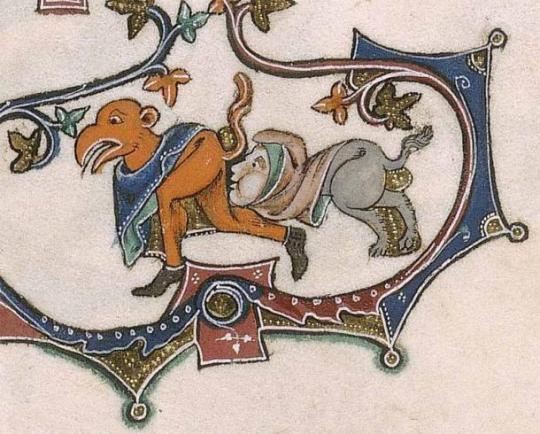
public domain Maccesfield Psalter
Appendage elements were also prevalent in early marginalia.
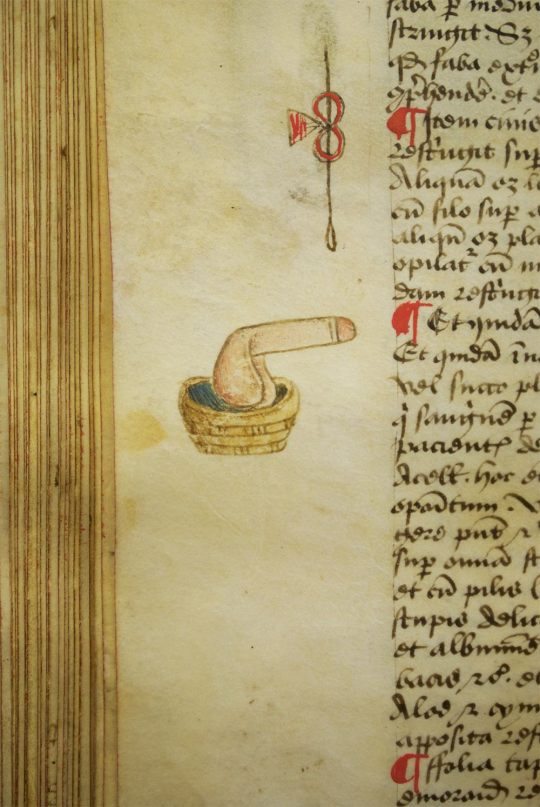
public domain Arderne’s treatise. GLASGOW UNIVERSITY LIBRARY MS HUNTER 251 (U.4.9)

public domain from the Roman de la Rose, c. 1325-1353. (Paris, Bibliothèque nationale de France, MS. Fr. 25526, f. 106v.)
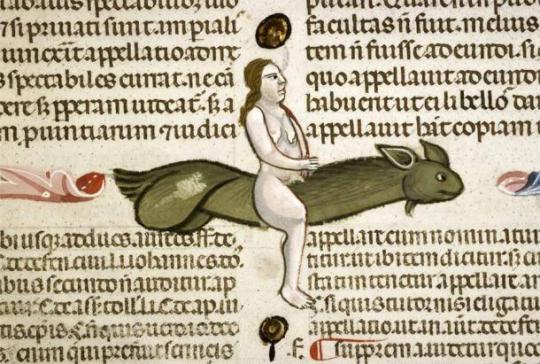
public domain Decretum Gratiani with the commentary of Bartolomeo da Brescia, Italy 1340-1345. Lyon, BM, Ms 5128, fol. 100r
Not all marginalia is grotesque, vulgar, and crude. There are many whimsical and charming examples, too!
Here are just a few random styles that do not fit into a specific category.

public domain from the Summer volume of the Breviary of Renaud and Marguerite de Bar, Metz ca. 1302-1305. (Verdun, Bibliothèque municipale, MS 107, f. 99v.)

public domain Cosmographie universelle, selon les navigateurs tant anciens que modernes / par Guillaume Le Testu, pillotte en la mer du Ponent, de la ville francoyse de Grâce (1555). Detail of ‘Mer de l’Inde orientale’ (p.64)

public domain Glasgow University Library MS Hunter 251 (u.4.9)

public domain Taymouth Hours, 14th c. The British Library ms 13, f. 142r

public domain The Gorleston Psalter, c. 1310 The British Library, ms 49622, f. 104v

public domain diurnal, France c. 1400 Avignon, Bibliothèque municipale, ms. 103, fol. 45r

public domain Paulus Kal: Fechtbuch, gewidmet dem Pfalzgrafen Ludwig - BSB Cgm 1507, [S.l.] Bayern, second half 15th century (not after 1479)

public domain book of hours, c. 1320 The British Library, Harley ms 6563, f. 78v

public domain Holy Land by Martin de Brion of Paris, France, 1540, Royal MS 20 A. iv, f. 3v
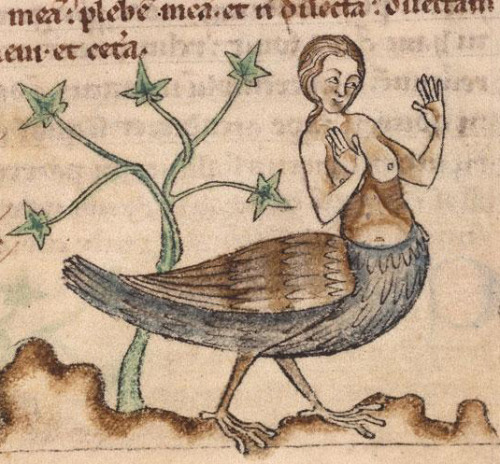
public domain Douai, Bibliothèque municipale, 0711, detail of f. 32. De natura animalium (13th century)
1 note
·
View note
Text
AMAZING ADVENTURES #16-17 (1973): Rutland Parade
AMAZING ADVENTURES #16-17 (1973): Rutland Parade
Beast continues to be portrayed as a monster in this series. It’s really good.
Beast (in his rubberized “secret identity” suit) and his girlfriend Vera get stuck with Steve Englehart, Roy and Jeannie Thomas, Gerry Conway, Mike Friedrich, and Glyn and Len Wein, in Rutland during their annual Halloween parade.
This is always a fun excuse for Marvel to poke at DC (or vice versa), and to depict…

View On WordPress
#Comic Book Creators Appearing in Comic Books#Forgotten Powers (that guy can do THAT?)#Halloween#Rutland Parade#Suicide in Comics
1 note
·
View note
Photo

Rutland Halloween Parade
Avengers #83 (1970)
Roy Thomas
John Buscema
Tom Palmer
Herb Cooper
#avengers#rutland halloween parade#roy thomas#John Buscema#tom palmer#herb cooper#70s comics#Marvel Comics
11 notes
·
View notes
Photo
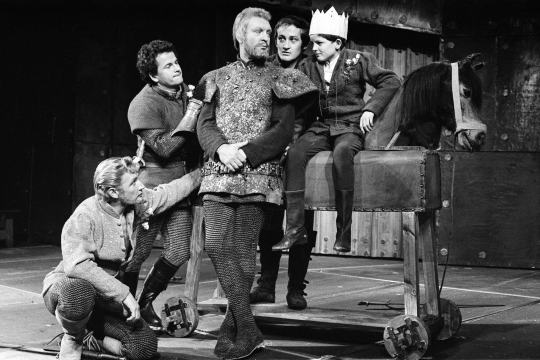
Ian Holm as Richard of Gloucester with Donald Sinden (Richard of York), Charles Kay (Clarence), Peter Gatrell (Earl of Rutland) and Roy Dotrice (Edward IV) in a photo call for “Edward IV” at the Royal Shakespeare Theater in Stratford-upon-Avon, England, in 1963.Credit...Bill Ellman/Mirrorpix, via Getty Images
Source.
#shakespeare#william shakespeare#rsc#royal shakespeare company#edward iv#Thomas Heywood#ian holm#Black and White#richard of gloucester#richard iii#1963#1960s#theater#theatre
14 notes
·
View notes
Photo



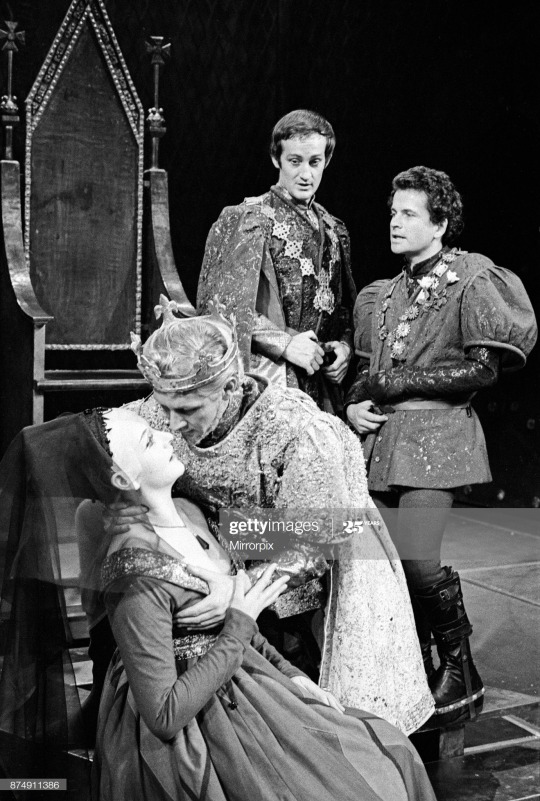
Ian Holm as Richard of Gloucester with Donald Sinden (Richard of York), Susan Engel (Lady Elizabeth Woodville Grey), Charles Kay (Clarence), Peter Gatrell (Earl of Rutland) and Roy Dotrice (Edward IV) in a photo call for “Edward IV” at the Royal Shakespeare Theater in Stratford-upon-Avon, England, in 1963.Credit…Bill Ellman/Mirrorpix, via Getty Images
Source.
@ardenrosegarden @suits-of-woe @malvoliowithin @superkingofpriderock @metropolitan-mutant-of-ark @amalthea9
#ian holm#sir ian holm#donald sinden#susan engel#charles kay#peter gatrell#rsc#roy dotrice#royal shakespeare company#theater#literature#history plays#histories#edward iv#rose tetralogy#3 henry vi#henry vi#richard iii#shakespeare#will shakespeare#william shakespeare#bardolatry
2 notes
·
View notes
Text
Another example of “the real Roy Keane”, which I believe should get at least the same amount of attention as his rants:
“Gary Charles and Roy Keane played together at Nottingham Forest.. In 1992, a teenage cyclist was killed when he collided with Charles' car. Charles was absolved of any blame but the legacy of the horror accident drove Charles to alcoholism. He was sentenced to four months in prison in 2004 for drink-driving and a year later was given a one-year sentence for threatening a nightclub bouncer. He entered the Rutland Centre a year later. Then, he received a letter from his old teammate Keano.
Keane's letter was lengthy, including the line "There but for the grace of god - what happened to you could have been me". Keane was the manager of Sunderland at the time, and offered Charles a role with the club to help him earn his coaching badges along with a bed at his family home. Charles took Keane up on the offer - and even occasionally took part in training at the club. He eventually earned his UEFA A Licence and has gone on to be Director of Football at the University of Nottingham.”
#yes his rants are funny#but this is the real Roy with the cameras off him#Roy Keane#roy keane being soft
10 notes
·
View notes
Note
Oh god I think I'm asking way too much and if I am feel free to ignore this message but 4, 12, 22, 24, 29, 30, 50 for the York family
Okay so quick disclaimer: I don’t know which York family you mean. I’m going to go with the Yorksquad™from the H6 cycle, but if you meant Aumerle and Parents then yeet
But I can do them too, you just need to specify that you meant them and not theYorksquad™
Yorksquad ™ includes: Richard of York, Cecily Neville (Duchess of York) and the Sons of York: Edward IV, George of Clarence, Richard III, and Edmund of Rutland.
Also for Shakespeare purposes Edmund of Rutland shall be the youngest brother per the H6 cycle even though historically he was older than everyone except Ed.
4. What would they do if they needed to make dinner but the kitchen was busy?
RoY: Orders everyone out of the kitchen. He needs to make dinner.
Cecily: Same as her husband but instead of just ordering everyone out she gets them all to make themselves useful and help her.
Edward: Says “well, since you guys are all in here I guess I can’t make dinner. Guess someone else will have to do it…” and then leaves.
George: Argues at everyone until they leave and let him make dinner.
Richard: Grabs a frying pan and starts swinging
Edmund: Probably isn’t allowed to make dinner anymore after that disaster with the omelettes
12. Favorite book genre?
RoY: Medieval fantasy. Duh
Cecily: I dunno I sort of have her pegged as the type to read Nonfiction And Classics Only but also have a selection of cheesy romance novels?
Edward: Anything smutty
George: A good old fashioned Graphic Novel
Richard: Probably gothic. Or true crime. Maybe he branches out into whodunit mysteries every once in a while.
Edmund: YA
22. Given a blank piece of paper, a pencil, and nothing to do, what would happen?
RoY: Nothing, he always has something to do
Cecily: Makes lists to organize and plan her daily events better
Edward: Writes crappy poetry to his girlfriend that he intends never to send to her but George and Richard will inevitably steal and give to her
George: Drawings of fun things like tigers and spaceships
Richard: Hangman. With himself. And also with George
Edmund: Super Hangman which is just Hangman with fingers and toes on the guy so you get extra guesses. Also tic tac toe. And drawings of dragons eating the Hangmen.
24. Is there one subject of study that they excel at? Or do they even care about intellectual pursuits at all?
RoY: Very good at physics somehow
Cecily: A maths person, for certain
Edward: Probably doesn’t care that much honestly. He’s a jock and gets decent grades but doesn’t excel at any one subject.
George: Botany
Richard: Gets straight As in everything because he’s obnoxious like that
Edmund: Art
29. Reaction to sudden extrapersonal disaster (eg The house is on fire! What do they do?)
RoY: Get everyone to safety, then attack the problem at its source if possible. Later, assess the damage and regroup.
Cecily: Stay calm and don’t freak out. Make sure everyone knows what they’re doing and can get safe as quickly as possible.
Edward: SAVE EVERYONE
George: Save no one, including yourself
Richard: Probably was the one who caused the disaster tbh
Edmund: Tempted to hide or act in some other childish way, but would actually be one of the best in a bad situation cause he would be the most concerned about safety.
30. Reaction to sudden intrapersonal disaster (eg close family member suddenly dies)
RoY: Stays stoic and strong for his family.
Cecily: Shows her pain, but only in terms of haughty suffering. No excessive displays or much regard for anyone else, really.
Edward: Masks everything and attempts to use his good humor and pleasant nature to keep everyone cheerful
George: Is distressed and obviously shaken, although he tries to be tough like everyone else.
Richard: Shows no outward signs of anything being wrong. At worst, he starts becoming avoidant and withdrawn. Possibly becomes temperamental
Edmund: Is clearly confused and will look to the others for comfort and guidance since he isn’t sure of himself yet.
50. Is this person afraid of dying? Why or why not?
RoY: No. There are many things he will die for. His family, his honor, his birthright. Life is only useful as long as you can bargain it for greater things.
Cecily: Not afraid as such, when death comes for her she’ll meet it brazenly, but she doesn’t really care to die either.
Edward: No. He’s very similar to his father and sees a certain glory in dying young.
George: Yes, and he hates himself for it, since his family is so damn brave and stubborn.
Richard: Yes, although he doesn’t exactly act like it or show it. It’s more that he doesn’t think he CAN die. And sure he’d put on a show of not caring, but he hates the thought of death. His, specifically.
Edmund: No. He thinks of death as peaceful and while he doesn’t want to die, is a lot like his mother and will not run from it.
9 notes
·
View notes
Photo

The mailman brought my subscription copy of JUSTICE LEAGUE OF AMERICA, another oversized installment in writer Steve Englehart’s excellent year-long run. Having left Marvel behind, Englehart agreed to do a year’s worth of Justice League stories for DC, and negotiated that they be of extra-length so that he could service the huge cast the series had. Long-time JLA artist Dick Dillin was productive enough to be able to turn out a 34 page art job every month--so for about a year, that’s what we got.

As I’ve mentioned previously, Englehart did for JLA much the same thing that he was known for on AVENGERS earlier. He focused on characterization and overarching plotlines, while at the same time drawing assorted strands from throughout the DC universe together in the manner that he learned from his mentor Roy Thomas. In this particular story, he incorporates aspects of DC’s supernatural titles into the mix, in particular Phantom Stranger.
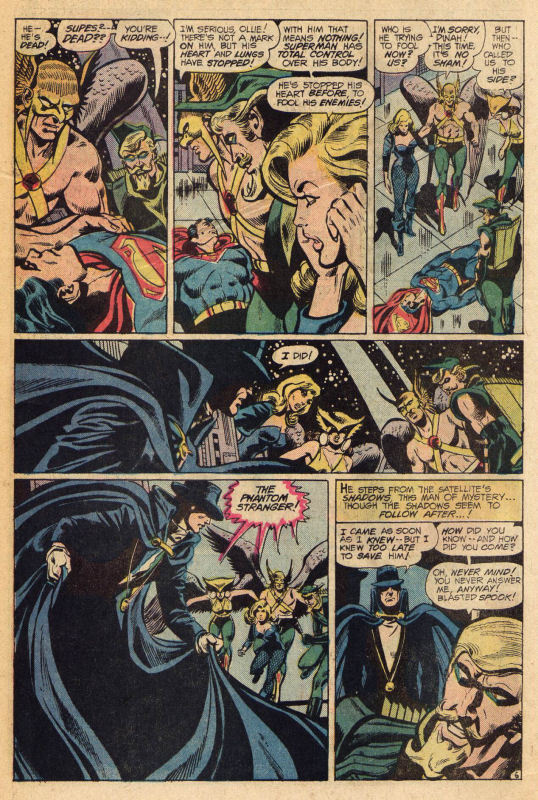
The issue opens with sorcerer Count Crystal summoning the demonic lord Azgore and pledging to provide him with the souls of the Justice League in exchange for mystical power. The bargain struck, Crystal transports himself to the JLA satellite headquarters, where Superman is on monitor duty, and promptly kills the Man of Steel. So yeah, that’s an opening! Meanwhile,.on Earth, Green Arrow and Black Canary and Hawkman and Hawkgirl have been out together, in an attempt to put an end to their long-running feud. Black Canary laments that the League’s dopey rule about not duplicating powers prevents Hawkgirl from becoming a member.

In the midst of this conversation, an alert from the JLA communicator comes in, but there’s nobody on the comm channel. Suiting up, the four heroes beams up to the satellite, only to discover Superman’s dead body. As the confused quartet tries to make sense of this, the Phantom Stranger steps from the shadows and indicates that he sent the emergency signal--not just to them, but also to Batman and Wonder Woman, who also arrive. Now they are seven, a mystic number, and equally balanced male and female, so the Stranger can perform a seance to contact Superman’s spirit and learn what transpired.

Superman’s angry spirit gives the team the lowdown on Count Crystal and demands vengeance, but the Stranger is hopeful that the Man of Steel can be restored. He mystically tracks Crystal to, of course, Rutland, Vermont, this time not at Halloween as was typical with the place. Crystal’s Carnival of Souls is parked on the outskirts of the town, and the JLA moves in to confront their foe, only to be outclassed by his mystic might.
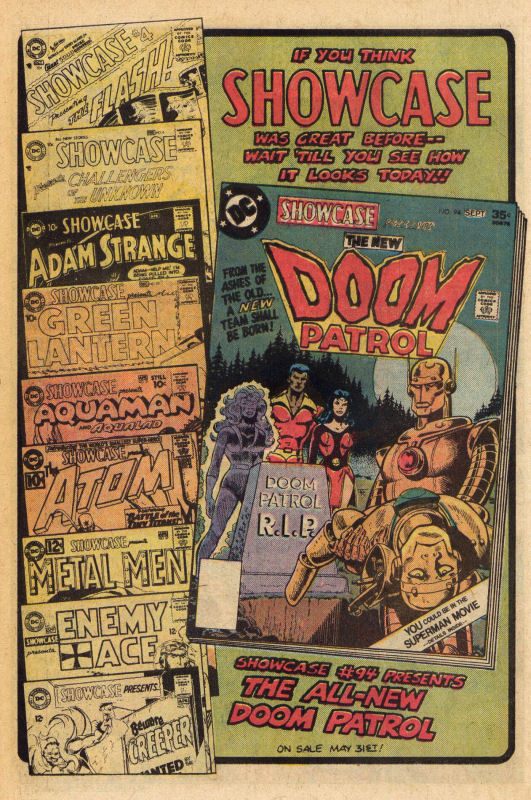
A pause here, as it’s about this point in the book where this ad ran. I was very excited by the prospect of a Showcase revival, especially one headlining a new iteration of the Doom Patrol, whom I had loved in reprints. So I would definitely be on the lookout for this book in the days and weeks to come.

Back at the carnival, the JLA find themselves mystically transported onto a roller coaster of death, where assorted magical menaces attack them along te way. Green Arrow is no help, having been struck by the sedative arrow that he’d earlier launched and Count Crystal. Only the Phantom Stranger has an effect on the creatures that assault the team, and he conjures them into substance so that the League can combat them--but he falls from the coaster car and the ground rushes up to meet him fatally. Like Superman, the Phantom Stranger is dead.

In the spirit realm, Superman has found his essence drawn down a spiraling path, to the domain of Azgore itself. He fights back valiantly, but he’s not Superman here, merely one more soul for Azgore to snack on. But he’s rescued by the surprise appearance of the Phantom Stranger’s shade--the Stranger allowed himself to be killed so that he could come to Superman’s aid. Hell of a plan, that. Back in the material world, Count Crystal has become enamored of Hawkgirl and spirits her away, while leaving the remaining Leaguers to combat his fearsome puttylike demon minions. Hawkgirl appears to succumb to his charms until she can get the drop on him and rescue the League.

At this point, Azgore has had enough of this nonsense. He’s given his power to Count Crystal, and the Count hasn’t been able to feed him even one Justice Leaguer. It’s far easier for him to cut his losses and simply consume Crystal’s soul--which he does. And as dawn breaks, the exhausted but intact Justice League counts their blessings and savors their victory--until a voice rings out from off-panel. A voice belonging to the Red Tornado, the android Leaguer who is dead. How is Reddy back again? For those answers, we’d need to come back next time. To Be Continued!

And finally, the issue closed out with another installment of my favorite feature, 100 Issues Ago in JUSTICE LEAGUE OF AMERICA. This time, the focus was on #45 from 1966, the story that introduced the League’s recurring nemesis the Shaggy Man, a gigantic, unkillable, unstoppable artificial Sasquatch creature who was running amok. The League eventually bested Shaggy man by having the scientist who created him make a second Shaggy Man, and then pitting them against one another and sealing up the cavern in which they fought behind them.
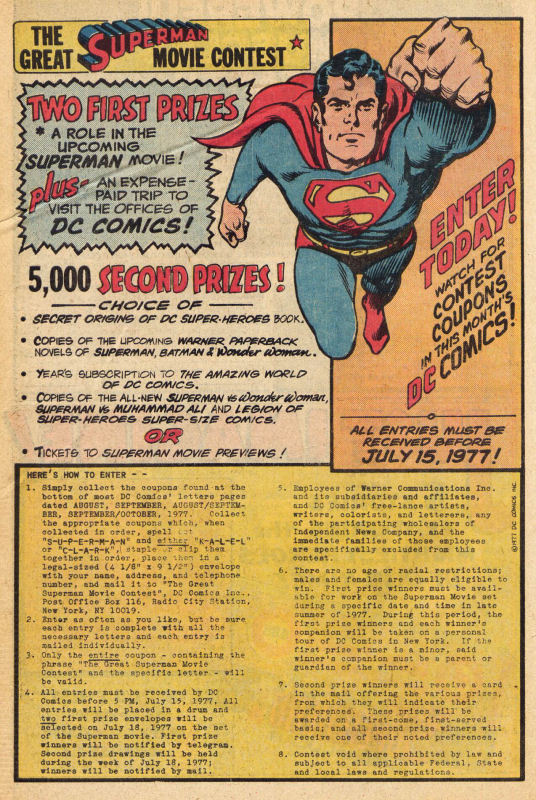
And I suspect that this ad represented my first awareness that there was a Superman movie being made. I didn’t enter this contest myself--and in fact i was relatively blase about the prospect of a Superman film. This was still before the era of Star Wars and the big budget special-effects blockbuster, so movies as a whole were only of limited interest to me at this point. That would change.
#Justice League of America#Steve Englehart#Dick Dillin#Phantom Stranger#death of Superman#Showcase#Doom Patrol#Superman the movie#Shaggy Man#DC
55 notes
·
View notes
Link
via Politics – FiveThirtyEight
Matt Lauer was fired last year from his job co-hosting NBC’s “Today” show in response to allegations of “sexual harassment.” Or was it “inappropriate sexual behavior”? Maybe “sexual misconduct.” These are all headlines about the same reports — just using different language to describe them. As the media scrambles to cover wave after wave of accusations, the variation in language is making an already difficult national conversation about what crosses the line even more so.
The #MeToo movement, a campaign against sexual violence that gained national attention from media reports on allegations against former Hollywood producer Harvey Weinstein, is no monolith. It has brought to light violent sexual wrongs whose heinousness makes them easily identifiable as not only grave moral transgressions but also potential legal ones. Alongside the black-and-white cases, however, are those that involve more subtle behaviors — unwanted touching, offensive jokes, staring and intrusive questions. And it is typically this latter category that has left society at a frustrating loss for words.
This inability to distinguish between different types of unwanted sexual behaviors has arguably had major consequences for a movement that is trying to shift these subtler behaviors from the realm of the historically overlooked to the currently unacceptable. For one, it has left #MeToo open to the (witch-hunt) criticism that bad actors of many different types are being lumped together, with the implication that they should all face the same consequences (to say nothing of the consequent lumping together of the experiences of the victims).
But a path forward, to a clearer vocabulary (and understanding), is possible. Social science research into the kinds of unwanted sexual behaviors that people experience in the workplace has led to the development of some potentially useful ideas and terms — gender hostility, unwanted sexual attention and sexual coercion — that might help put a name to some of the #MeToo-highlighted behaviors. And there’s precedent for this kind of change: Sexual harassment was introduced as a concept and a term only in the past 45 years and is now in common usage.
We have seen this language problem play out several times since the Weinstein articles were published, but perhaps most prominently in the case of Al Franken. He was a Democratic senator from Minnesota at the time that he was accused of groping and forcibly kissing women at photo ops or events — allegations that were frequently described in headlines with the catch-all term “sexual misconduct.” Franken resigned from office, prompting some liberal commentators to argue that he had been treated unfairly by a movement that was failing to draw distinctions between the variety of accusations being leveled against prominent and powerful men and that a ruined career should not be the consequence of every allegation made via #MeToo. Comparisons between the nature of the accusations against Franken and those against other accused men, including Roy Moore, then the GOP Senate candidate from Alabama, were often wielded as evidence in these articles. The first report that Moore had initiated sexual encounters with teenaged girls when he was in his 30s was published a week before the first Franken allegations surfaced.
Ginger Rutland, a former editorial writer at The Sacramento Bee and a self-identified Democrat, wrote in an op-ed in December: “Sen. Al Franken is not Roy Moore. He isn’t even Harvey Weinstein or Matt Lauer. At most, Franken … is guilty of boorish behavior — not assault, not pedophilia, not even sexual harassment. But with today’s fast-changing, contradictory and confusing reversal of sexual norms, he’s being burned at the stake, walked down the plank, buried alive.”
The allegations against Franken surfaced at the height of Moore’s Senate campaign, and partisanship inevitably played a major role in the response to each. Democratic voters and elected officials (eventually) pushed Franken to resign. Many Republicans stood by Moore. But the two cases were consistently discussed as a pair — even if it was in an attempt to explain why they were different. If a more appropriate vocabulary existed to discuss Franken’s behavior, the situation might have played out differently, and maybe allegations against him and Moore could have been in separate categories from the start.
“People like to use ‘sexual misconduct’ as the basket in which they throw things that they don’t think are bad enough to call sexual harassment,” said Louise Fitzgerald, a professor emeritus of psychology and gender and women’s studies whose research interests include sexual violence. “They want to say things like, ‘Al Franken didn’t commit sexual harassment; it was sexual misconduct,’ and what they’re trying to say is that it wasn’t that bad. But nobody really articulates what they mean by “‘bad.’”
We spoke with seven experts in the fields of psychology, law and communications who have studied gender and sexual dynamics, including Fitzgerald, and they generally agreed that the lack of precise language for some of the behaviors being discussed via #MeToo is a problem.
Naomi Mezey, a professor at Georgetown University’s law school and co-director of the Georgetown Gender Justice Initiative, said umbrella terms such as “sexual misconduct” or “inappropriate behavior” that were being used to describe the unwanted sexual behaviors of men were contributing to the backlash against the movement. “Words like ‘sexual misconduct’ mean everything from rape to a bad date,” she said. “People fear that we’re making the most basic interactions illegal.” She said there would be benefits to breaking down those sweeping terms: “We can think more carefully about the ways in which women feel sexually abused and can think more carefully about what kinds of things we want to make impermissible and permissible.”1
Although the media and society at large are struggling to articulate and understand the differences between unwanted sexual behaviors, social scientists have been thinking about these distinctions for decades. Some have proposed categories that are more specific than the umbrella terms of “sexual misconduct” and “sexual harassment.” And these conceptual frameworks could be a starting point for an expansion of the public’s understanding of, and vocabulary for, unwanted sexual behaviors.
One of these systems was developed by Fitzgerald. Between the late 1980s and early 2000s, she and her team created a framework for sexual harassment that distributes 16 behaviors — such as, “told sexual stories or jokes” and “made unwanted attempts to stroke, fondle or kiss” — across three categories:
Gender hostility refers to derogatory comments or actions that invoke sex or gender, rather than explicit requests for sex. There are two types — sexist hostility, which is specific to gender (for example, if someone made a joke about women in a meeting) and sexual hostility, which has a sexual component (for example, if someone asked about a co-worker’s sexual activities).
Unwanted sexual attention includes unwelcome attempts to initiate sexual or romantic relations (for example, when someone repeatedly asks a co-worker out on dates).
Sexual coercion involves many of the same behaviors as the previous category, but with the explicit threat of consequences — such as being refused a promotion — for not cooperating.
Fitzgerald and her team created the list of behaviors, which you can see below, by building on the work of previous scholars and researching women’s experiences. The conceptual categories also correspond to the legal standards for sexual harassment: The first two constitute the legal idea of a “hostile environment,” and the third maps to “quid pro quo” harassment.
There’s value to going beyond the legal categories, Fitzgerald said. “The most important thing in the world is to know what it is exactly you’re talking about, and sexual harassment is so much more than a legal category,” she said. “It’s an experience. We want to know what all aspects of that experience could be.”
Fitzgerald and her team used this framework to build a survey called the Sexual Experiences Questionnaire, which asks respondents whether they’ve experienced the specific behaviors. Versions of this survey have been applied to a variety of organizations since then, including colleges and the military, to understand the prevalence and types of harassing behaviors that occur within organizations. Over decades of the survey’s use, Fitzgerald has found that the conceptual categories remain relevant: “The categories cover the universe,” she said.
Any attempt to quantify human behavior has shortcomings, of course. Fitzgerald acknowledges that there are challenges:
Whether something is offensive or unwelcome depends on the perspective of the person who is experiencing it, she said. Inviting a colleague to dinner, for example, could be seen as an attempt to have sex or to do some innocuous professional networking.
This kind of framework can’t be used to determine whether some behaviors are inherently worse than others.
The 16 behaviors that the framework and survey depend on have not been updated recently. That means that any new kinds of unwanted behavior — for example, something like sexting that is the result of technological innovation — hasn’t been taken into account.
Expanding the public’s understanding of behaviors of a sexual nature that may be violating and how we talk about them might seem like a far-off goal. But it’s been done before, with the help of activists and scholars, who played a key role in the development and promotion of the term “sexual harassment” in the 1970s.
“This is an area where academics have been especially helpful in moving the law forward,” said Gillian Thomas, a senior staff attorney for the American Civil Liberties Union Women’s Rights Project.
There have long been terms to describe the most violent sexual behavior, like “rape” and “sexual assault.”2 But starting in the 1970s, the concept of sexual harassment was introduced to refer to other behaviors that people find uncomfortable and harmful, particularly in work and organizational settings. A group of women who were working at Cornell University first used the term to describe unwanted sexual advances at work, and coverage of their activism helped get that phrase into headlines. Around the same time, a book by legal scholar Catharine MacKinnon defined the two types of behavior that eventually became the foundation of the legal notions of sexual harassment: “quid pro quo” and “hostile environment” harassment. And her work was key to the establishment of sexual harassment in the workplace as sex-based discrimination under the Civil Rights Act of 1964.
Today, the Equal Employment Opportunity Commission enforces federal anti-discrimination laws in the workplace. Unlawful sexual harassment includes “unwelcome sexual advances, requests for sexual favors, and other verbal or physical harassment of a sexual nature” as well as “offensive remarks about a person’s sex,” according to the agency’s website. But there are limits: The agency also notes that the law doesn’t “prohibit simple teasing, offhand comments, or isolated incidents that are not very serious” and that harassment is only illegal when it is recurrent or severe.
But as #MeToo has shown us, the understanding of what constitutes unwanted sexual behavior — and how to talk about it — continues to evolve. Tools for moving the conversation forward exist. Will one part of the movement’s legacy be to push society to find the right words to describe it all?
4 notes
·
View notes
Photo

Remember when I said Jim Starlin did a comic about aliens trying to brainwash Adam Warlock with the image of a clown being crucified? Well, as luck would have it, I just learned there’s a story behind it all.
I quickly got suspicious about the aliens in Strange Tales #181, because they looked more like Starlin drawing real people than fantasy comic book people. (For one thing, they have lines on their faces and unremarkable facial hair and dull 70s haircuts.) One of them had a conspicuous nametag reading “Len,” even though you don’t need to know what this guy’s name is. Then “Jan Hatroomi” showed up, and I couldn’t work out the anagram, but I knew I was in trouble. Turns out, Starlin was venting hostility at his bosses: publisher Stan Lee, art director Jon Romita, outgoing editor-in-chief Len Wein, and incoming editor-in-chief Marv Wolfman. (The clown on the cross is former EIC Roy Thomas.)
There was probably a time in the distant past when I believed it would be clever for the people who make comic books to depict themselves and people they know in a comic book. If so, that would have been before I started reading 1970s superhero comics, where this bit seemed to happen all the frigging time. (There was a whole running gag that revolved around the annual Halloween parade in Rutland, Vermont.) It’s one thing to do a brief cameo, or a cute joke about showing the writers/artists coming up with the content for the comic you’re reading. It’s quite another to grind the story to a halt so that two or three funny-looking guys can drop enough hints to be sure the readers are in the gag.
The goofiest thing about Strange Tales #181 is that Starlin’s rant about Marvel restricting his creative freedom was approved and published by Marvel, making it even less clear what the hell he was complaining about. Starlin would go on to quit and return to Marvel half a dozen times, so his beef back then must be ice cold now. So the only net effect of his little protest, is to irritate some guy (me) who wasn’t even born when it came out. Trippy.
4 notes
·
View notes
Photo

Águia Pesqueira (Pandion haliaetus) by Pedro Olivença R20_1916b Roy Dennis Wildlife Foundation Antigamente existia uma população de águias pescadoras reprodutoras ao longo da costa de Portugal, mas no último século o número diminuiu drasticamente, devido aos disparos e perturbações, deixando apenas um par. No final dos anos 1990, um grupo de ornitólogos portugueses me perguntou sobre a possibilidade de reintrodução de águias-pescadoras. Pedro Beja e Rita Alcazar vieram ver o nosso projeto na Rutland Water e as águias pescadoras na Escócia. No outono de 1997, Luis Palma da Universidade de Faro e seus colegas organizaram um workshop de especialistas para discutir seu projeto, que eles apresentaram ao seu governo em Lisboa. Infelizmente, eles nunca tiveram uma resposta positiva e, finalmente, o último pássaro macho também desapareceu. Em 2011, Luís, Pedro e os seus colegas obtiveram finalmente autorização para proceder à reintrodução de uma águia-pescadora e, com o apoio de ornitólogos finlandeses e suecos, jovens águias-pescadoras foram translocadas e libertadas no leste de Portugal. Em 2012, Roy Dennis foi convidado a participar no workshop anual sobre o projeto de reintrodução em Portugal e mais jovens águias-pescadoras chegaram da Escandinávia para serem lançadas em julho de 2012. www.roydennis.org/animals/raptors/osprey/species-recovery... https://flic.kr/p/2k6kebP
0 notes